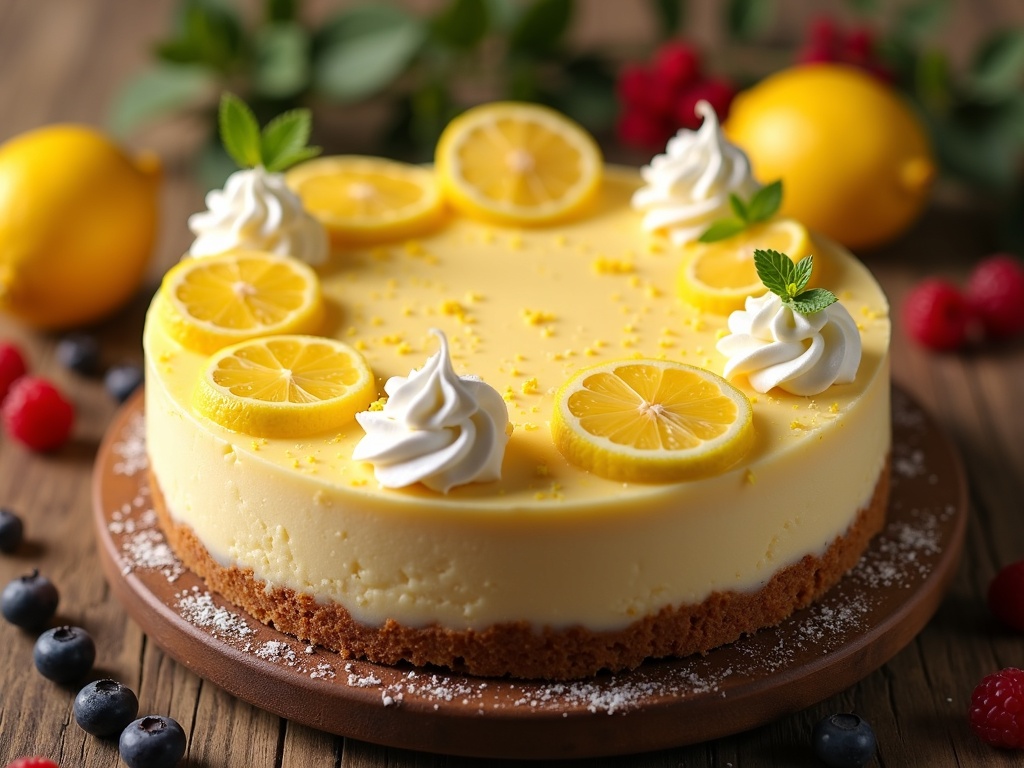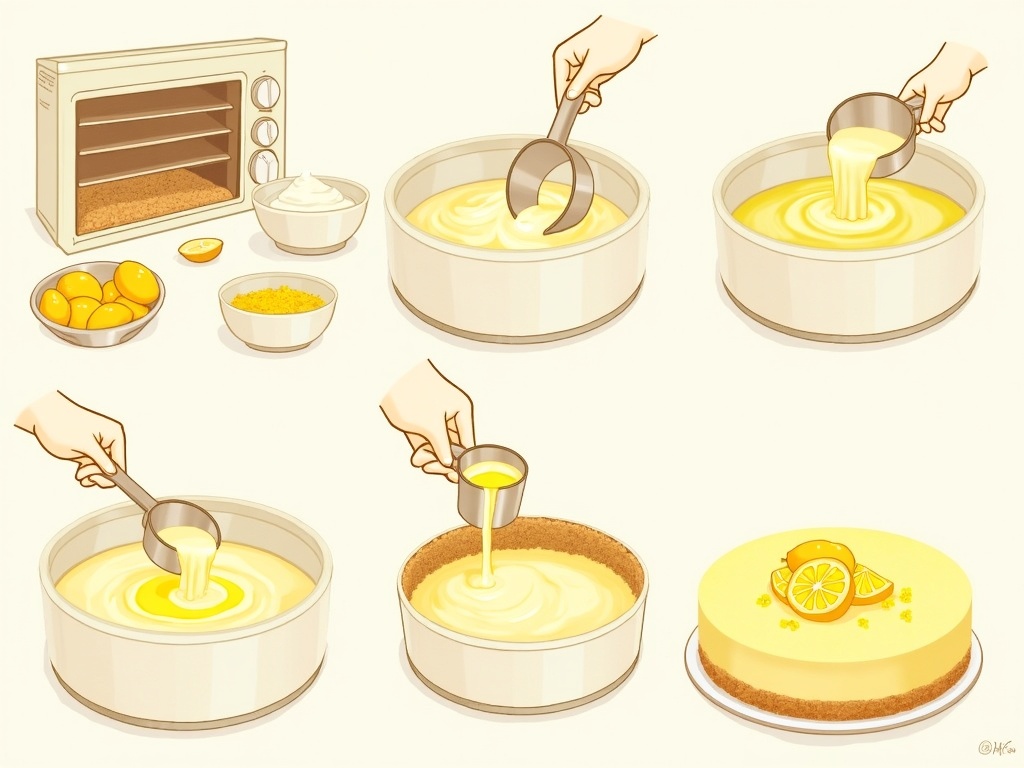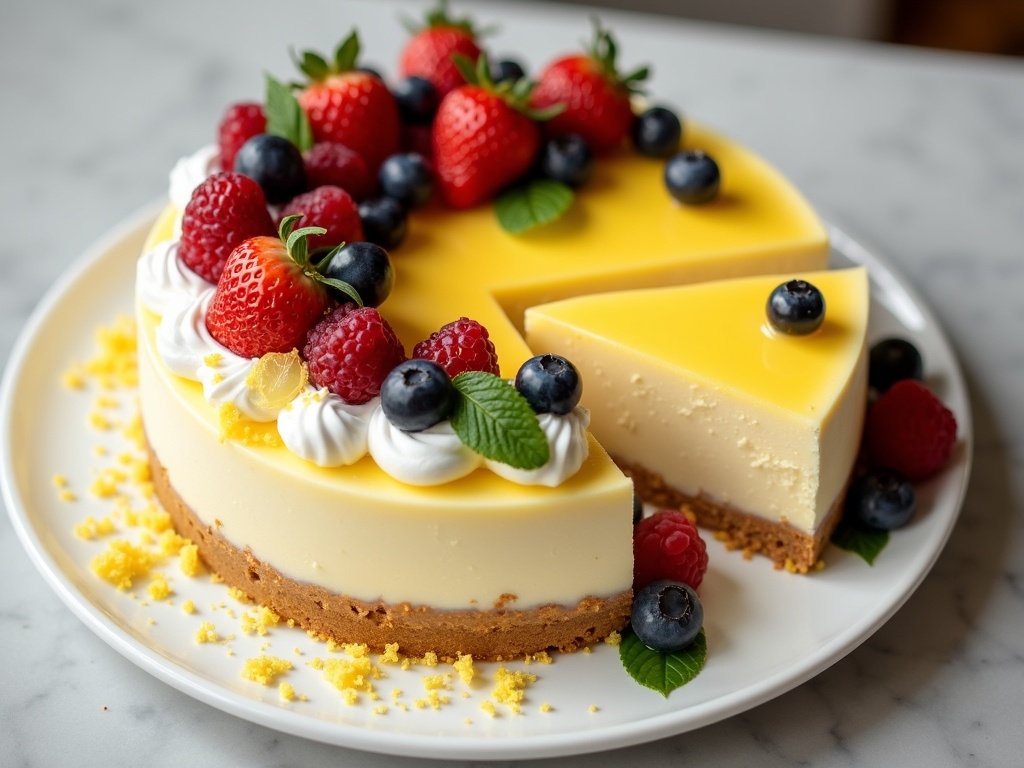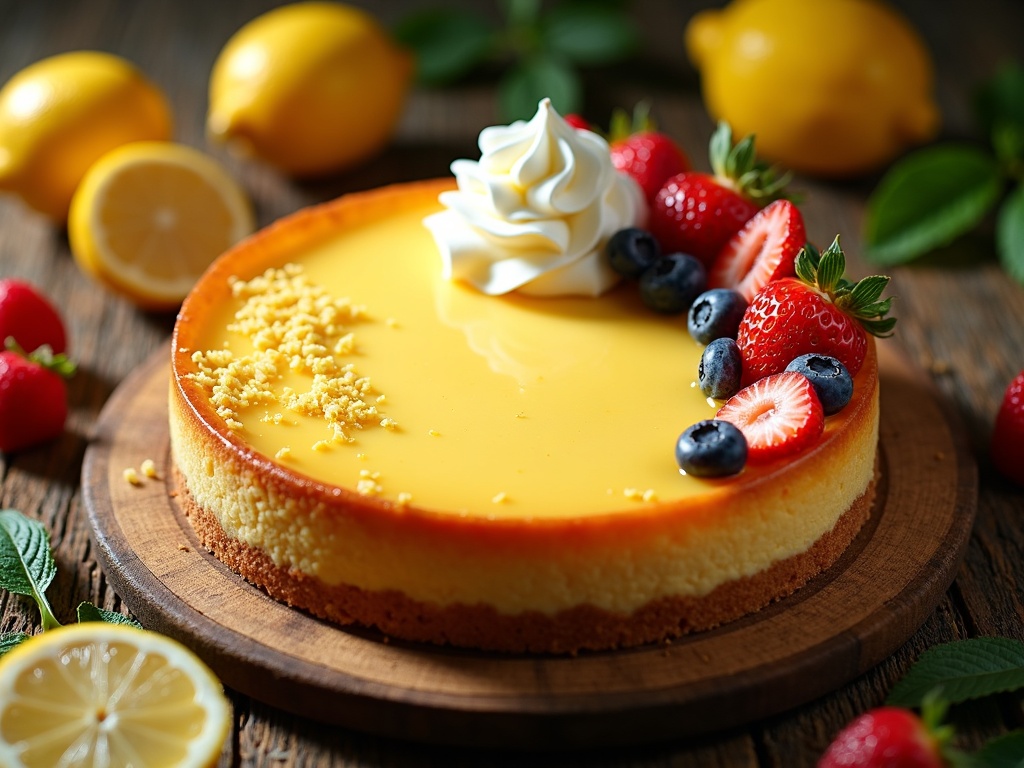The lemon cheesecake recipe has risen to become one of the most popular cheesecake varieties, now accounting for 20% of all cheesecake sales due to its perfect balance of creamy richness and bright citrus notes. This beloved dessert strikes the ideal sweet-tart balance, offering a velvety cream cheese base complemented by refreshing lemon that creates a versatile treat suitable for any season.
Find In This Article
Key Takeaways
- The classic recipe combines a graham cracker crust with a filling made from cream cheese, sugar, eggs, fresh lemon juice, and lemon zest for the perfect texture and flavor.
- Room temperature cream cheese and fresh lemon juice (rather than bottled) are crucial for achieving the best texture and most vibrant flavor.
- Baking at 325°F** in a water bath helps prevent cracking, while gradual cooling in the oven creates the perfect cheesecake texture.
- Fresh berries, whipped cream, and lemon zest make excellent garnishes that enhance both presentation and flavor.
- The dessert can be made lighter by substituting Greek yogurt for some of the cream cheese or using natural sweeteners instead of refined sugar.
The Perfect Lemon Cheesecake recipe: What Makes It Special
I’ve found that lemon cheesecake stands apart in the dessert world by masterfully balancing creamy richness with bright citrus notes. This delightful combination creates a truly special treat that satisfies multiple cravings at once. The marriage of smooth cream cheese and zesty lemon creates a flavor profile that’s both refreshing and indulgent.
A Growing Favorite Among Dessert Lovers
Cream cheese consumption has risen by 11% over the last decade, showing just how much we’ve embraced cheesecake as a beloved dessert option. Within the cheesecake market, lemon-flavored varieties now represent 20% of all sales, making it one of the most popular flavor choices available.
The appeal of lemon cheesecake lies in its perfect sweet-tart balance. Unlike some desserts that overwhelm with sweetness, this treat offers:
- A velvety cream cheese base that delivers richness without being heavy
- Bright citrus notes that cut through the richness
- A versatile flavor profile that works year-round
- The ability to be paired with various toppings like fresh berries or whipped cream
This balanced approach makes lemon cheesecake appealing to both dedicated citrus enthusiasts and those who typically gravitate toward creamier desserts. The tanginess of lemon provides the perfect counterpoint to the luxurious texture of a classic baked cheesecake recipe.
For those who enjoy experimenting with flavors, lemon cheesecake serves as an excellent base for further customization. I’ve found it pairs beautifully with other ingredients like blueberries, white chocolate, or even a hint of ginger for added complexity. This adaptability puts it ahead of the traditional American cheesecake in terms of versatility.
While cookie-based varieties like Biscoff cheesecake have their devoted fans, lemon cheesecake offers something unique – a dessert that feels simultaneously refreshing and comforting. The citrus element makes it feel lighter than many other cheesecake options, despite delivering the same satisfying creaminess.
Whether served at summer gatherings or winter celebrations, lemon cheesecake maintains its appeal across seasons and occasions, making it a reliable go-to dessert that consistently impresses guests and satisfies cravings for something both sweet and tangy.

Everything You Need to Make It
Creating a delicious baked cheesecake with bright lemon flavors requires quality ingredients and a bit of preparation. I’ve gathered everything you’ll need to make this citrusy treat that’s sure to impress your family and friends.
Base Components
The foundation of any good cheesecake is a buttery, slightly sweet crust that complements the creamy filling. For this lemon cheesecake, you’ll need:
- 2 cups crushed graham crackers
- 1/2 cup granulated sugar
- 1/2 cup melted unsalted butter
This combination creates the perfect crunchy base that holds together without being too hard or crumbly. The graham crackers provide that classic cheesecake foundation, while the butter acts as the binding agent. If you prefer a less sweet crust, you can reduce the sugar slightly without affecting the texture.
Creamy Filling and Flavoring
The star of any cheesecake is its velvety filling. For this lemon version, I’ve carefully selected ingredients that create the perfect balance of richness and citrus brightness:
For the creamy base:
- 24 oz room temperature cream cheese
- 1 cup granulated sugar
- 3 large eggs
For the lemon flavor:
- 1/4 cup fresh lemon juice
- Zest of 1 lemon
- 1 teaspoon vanilla extract
The room temperature cream cheese is non-negotiable – this prevents those frustrating lumps that can ruin the texture of your American cheesecake. I always set my cream cheese out at least 2 hours before I plan to bake. Cold cream cheese simply won’t blend properly, no matter how long you mix it.
Fresh lemon juice makes all the difference in this recipe. While bottled juice might seem convenient, it lacks the bright, intense flavor that fresh lemons provide. The oils in the zest also add another dimension of citrus flavor that can’t be replicated with juice alone.
I’ve found that the combination of lemon and vanilla creates a more rounded flavor profile. The vanilla softens the sharp edges of the lemon without diminishing its character, resulting in a more sophisticated taste.
For those who enjoy texture variations, you might consider adding a Biscoff cheesecake element by replacing some of the graham crackers with crushed Biscoff cookies. This adds a subtle spiced caramel note that pairs surprisingly well with lemon.
When gathering your ingredients, quality matters. Higher fat content cream cheese produces a richer cheesecake, and organic lemons often have more flavorful zest. I also recommend using large eggs rather than extra-large or jumbo, as the recipe has been calibrated for this specific size.
With these ingredients on hand, you’re fully equipped to create a stunning lemon cheesecake that strikes the perfect balance between creamy richness and refreshing citrus flavor. The brightness of the lemon cuts through the richness of the cream cheese, making this dessert feel lighter and perfect for any season.
Step-by-Step Baking Guide
Making a lemon cheesecake might seem challenging, but I’ve broken it down into manageable steps that will have you creating this tangy treat in no time. The key is to follow each stage carefully to achieve that perfect balance between creamy texture and zesty flavor.
Creating the Perfect Lemon Cheesecake
First, I preheat my oven to 325°F (163°C). This moderate temperature ensures the cheesecake bakes evenly without browning too quickly on top. While the oven heats up, I prepare the crust by combining graham cracker crumbs with sugar and melted butter. This mixture should have a wet sand consistency when pressed between your fingers.
I press this mixture firmly into the bottom of a springform pan, using the flat bottom of a measuring cup to create an even layer. A well-packed crust prevents crumbling when serving your baked cheesecake later.
For the filling, I beat cream cheese until completely smooth—about 2 minutes on medium speed. Lumps at this stage will remain in the final product, so patience pays off here. Next, I gradually add sugar while continuing to beat the mixture.
The eggs go in one at a time, allowing each to fully incorporate before adding the next. This technique creates that signature silky texture found in an American cheesecake while maintaining stability.
Now for the star ingredients that transform this into a lemon cheesecake:
- Fresh lemon juice (about 1/4 cup) for bright acidity
- Lemon zest (2 tablespoons) for intense citrus aroma
- Vanilla extract (1 teaspoon) to balance the tartness
I pour this mixture over the prepared crust and smooth the top with a spatula. For extra insurance against cracking, I place the springform pan in a larger baking dish with hot water coming halfway up the sides.
The cheesecake needs to bake for 50-60 minutes. I know it’s done when the center still has a slight jiggle—similar to setting gelatin. The edges should be more set than the middle.
After baking, I turn off the oven, crack the door open, and let the cheesecake cool gradually for about an hour. This gentle cooling helps prevent the surface from cracking.
Finally, I refrigerate the cheesecake for at least 4 hours, though overnight chilling produces the best flavor and texture. The waiting is the hardest part, but that first creamy, lemony bite makes it all worthwhile.

Make It Look Amazing
The final touch to any American cheesecake is its presentation, and my lemon cheesecake deserves nothing less than spectacular styling. Visual appeal can transform a delicious dessert into an unforgettable one.
Garnish Options That Pop
Fresh fruit garnishes are incredibly popular for good reason – about 75% of people prefer them on their cheesecakes. I’ve found that vibrant berries create a stunning contrast against the pale yellow surface of a baked cheesecake. Here are some perfect pairings:
- Fresh strawberries, either whole with stems for height or sliced in a fan pattern
- Plump blueberries scattered across the top or arranged in decorative circles
- Raspberries for a touch of elegant red that complements the tartness
- Blackberries for dramatic color and texture contrast
A swirl of whipped cream adds a cloud-like softness that beautifully complements the citrus flavor. I pipe small dollops around the edge or create a beautiful border that frames the cake.
For an extra lemony punch, I sometimes add a thin lemon glaze that gives the cheesecake a glossy finish and intensifies the flavor. This simple addition – just powdered sugar and fresh lemon juice – creates an irresistible sheen.
Don’t forget the power of fresh lemon zest sprinkled across the top! Those tiny yellow flecks don’t just add flavor; they signal to everyone exactly what delicious experience awaits them. For special occasions, I might even candy thin lemon slices to create a sophisticated decoration that’s both beautiful and edible.
The way you slice and serve matters too. Clean cuts with a knife dipped in hot water between slices ensure each piece looks as good as it tastes. For an extra special presentation, I place each slice on a plate with a mint leaf and additional berries for a cheesecake that’s ready for its close-up.
Remember, we eat with our eyes first, so taking that extra minute to style your lemon cheesecake isn’t just fussy decoration—it’s part of the complete dessert experience.

Smart Choices and Nutrition
Lemon cheesecake is undoubtedly a delicious treat, but I’m aware that understanding its nutritional profile helps you make informed decisions about enjoying it. A typical slice of lemon cheesecake contains approximately 350 calories, which represents about 10% of the recommended daily caloric intake for an average adult.
Nutritional Breakdown
When looking at the macronutrients, each slice typically contains around 24g of fat, 28g of carbohydrates, and 6g of protein. These numbers can vary depending on the specific recipe and portion size. The fat content primarily comes from the cream cheese and butter in the crust, while the carbohydrates are mainly from the sugar and biscuit base.
I find that being aware of these numbers doesn’t mean eliminating cheesecake from your diet—it’s about making room for it within a balanced eating plan. For special occasions or weekend treats, a slice of rich, creamy baked cheesecake can be perfectly reasonable.
Lighter Alternatives
If you’re looking to reduce the calorie content while still enjoying the bright, zesty flavors of lemon cheesecake, I’ve found several effective substitutions:
- Replace regular cream cheese with a lighter version to cut down on fat content
- Substitute part of the cream cheese with Greek yogurt for added protein and fewer calories
- Use a natural sweetener instead of refined sugar to reduce the carbohydrate content
- Create a thinner crust or use crushed nuts instead of traditional biscuits
- Consider a no-bake cheesecake variation that might require less fat for structure
The Greek yogurt substitution is particularly effective—it maintains the tangy flavor profile that pairs beautifully with lemon while significantly reducing the calorie count. Plus, it adds extra protein, making your dessert slightly more nutritionally balanced.
Remember that moderation is key. Including a reasonable portion of cheesecake occasionally can be part of a healthy, balanced diet. The lemon in this recipe adds a refreshing citrus element that makes it feel lighter than other cheesecake varieties, even if the calorie count remains similar.
Sources:
American Dairy Association, “The Rising Popularity of Cheesecake.”
National Confectioners Association, “Dessert Trends in America.”
United States Department of Agriculture, “Dietary Guidelines for Americans.”

